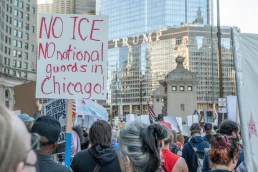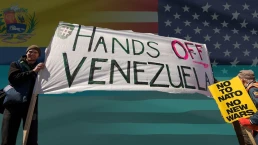Someone in the United States dies of COVID-19, a largely preventable disease, about every four minutes – equivalent to a deadly disaster on the scale of the 9/11 attacks every eight or nine days.
By Amy Goodman and Denis Moynihan, Democracy Now!
“We are certainly right now in this country out of the pandemic phase,” Dr. Anthony Fauci, President Biden’s chief medical advisor, told the PBS Newshour this week. Not all experts agree. “With all due respect to Dr. Fauci. I think we are still very much in a pandemic in this country,” Dr. Jonathan Reiner of the George Washington School of Medicine told CNN. “Cases have risen in the United States over 60%. Currently there are 15,000 people hospitalized in the United States with COVID-19 and and that number has risen by almost 2000 people over the last couple of weeks…And because hospitalizations are rising, we will soon see deaths rising.”

Dr. Fauci did announce he would not be attending the White House Correspondents’ Association dinner on Saturday. “I’m 81 years old, and if I get infected, I have a much higher risk,” he told CNN. It is predicted that by Memorial Day, one million Americans will have died of COVID-19, almost certainly an undercount. Fauci also acknowledged, “if you look at the global situation, there’s no doubt this pandemic is still ongoing.”
The Biden administration is at an impasse with Congress over emergency funds to confront the pandemic. Biden’s $22.5 billion request for COVID funding was stripped out of the $1.5 trillion appropriation bill that passed in mid-March. A partial funding agreement is back on the table, but it eliminates the $5 billion Biden requested for global vaccination efforts.
“So far, Congress has not stepped up to provide the funds that are needed for our most urgent needs,” Dr. Ashish Jha, the new White House COVID Response Coordinator, said at a news briefing this week. Among those needs are the purchase of millions of doses of COVID-19 vaccines to provide initial shots and boosters, in preparation for a potential surge this coming fall, and development of a new generation of vaccines that could potentially protect against multiple new variants. Expanding availability of Prizer’s antiviral pill, Paxlovid, is another major, unfunded priority, as is the provision of AstraZeneca’s Evusheld, an antibody treatment that can be taken in advance by immunocompromised people to shield them from infection.
Another White House funding priority is the distribution of vaccines globally. “We’ve got to get the resources we need to get shots in arms so we can actually vaccinate the world and help bring this pandemic to a close,” Jha said at the news briefing on Tuesday.
At the moment, the U.S. government has no money allocated for this. To date, the U.S. has delivered half a billion vaccine doses to 114 countries. Dr. John Nkengasong, director of the Africa Centers for Disease Control and Prevention, credits the U.S. effort, but says much more needs to be done.
“2022 must be the year that we completely tip the balance in favor of increased vaccinations in the developing world, especially in Africa,” Dr. Nkengasong said on the Democracy Now! news hour. “This is the year we must vaccinate at scale and at speed, if we have to defeat the emergence of new variants…Omicron taught us a lesson that any threat anywhere in the world is a threat everywhere in the world.”
A recent study by the Kaiser Family Foundation highlights COVID’s ongoing threat here in the U.S., especially for the unvaccinated. “Approximately 234,000 deaths since June 2021 could have been prevented with primary series vaccination,” the report states. “These vaccine-preventable deaths represent…a quarter of the nearly 1 million COVID-19 deaths since the pandemic began.” Kaiser also reports that, in January 2022, COVID-19 was the single greatest cause of death in the U.S. for those aged 45-84, and the fourth greatest cause of death overall.
Someone in the United States dies of this largely preventable disease about every four minutes – equivalent to a deadly disaster on the scale of the 9/11attacks every eight or nine days.
The WHO’s target of vaccinating 70% of the population in poor and developing nations by the end of June, 2022 is not going to be met, in part due to the U.S. government’s elimination of funding for the effort. This could very well lead to the emergence of new, potentially more transmissible and deadlier coronavirus variants. In our globalized world, these threats need to be met with a global response. As drug manufacturers make record profits, ensuring vaccine access around the world is not only a moral imperative, but a practical, achievable goal that protects us all.
Recent Posts
Anti-ICE Resistance Sprang Up Across Red States In 2025
December 29, 2025
Take Action Now In Texas, North Carolina, Alabama, Tennessee, Florida, and beyond, grassroots resistance to ICE is growing.By Sonali Kolhatkar,…
Trump Suggests US Bombed ‘Big Facility’ in Venezuela. No One Seems to Know What He’s Talking About
December 29, 2025
Take Action Now Administration officials have yet to provide any details about the supposed strike, which would mark a massive escalation in the…
Nigerian Village Bombed by Trump Has ‘No Known History’ of Anti-Christian Terrorism, Locals Say
December 28, 2025
Take Action Now “Portraying Nigeria’s security challenges as a targeted campaign against a single religious group is a gross misrepresentation of…
How Effective Are Protests? Historians Say: Very.
December 27, 2025
Take Action Now Protests change the protesters, their communities and the nation. From emancipation to women’s suffrage, civil rights and BLM, mass…




